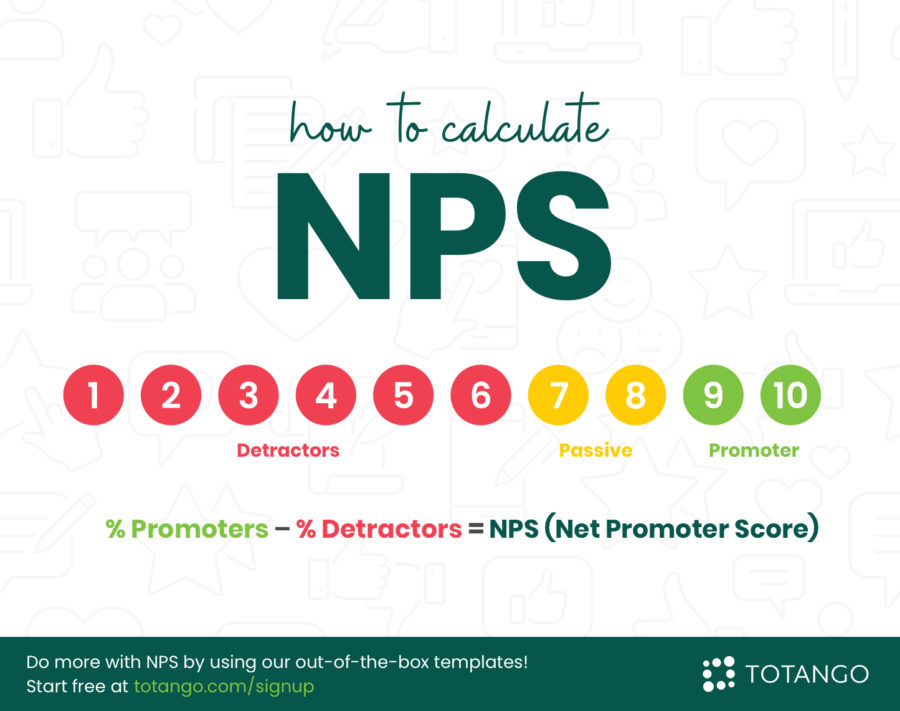Net Promoter Score tells you how likely customers are to recommend you, but is that all you need to know for customer success? NPS scoring is good as far as it goes, but it only provides insight into one facet of your customers’ sentiment toward your brand. You need a more complete view of your customer for success management. Here we’ll look at what NPS score tells you and what its limitations are. Then we’ll suggest some other metrics you can use to compensate for the limitations of NPS scoring.
How Does NPS Scoring Work?
To understand the limitations of NPS scoring, it will be helpful to recap how NPS scores are calculated. The NPS system measures customer satisfaction by asking a question modeled on the phrase, “How likely is it that you would recommend X to a friend or colleague?” The variable X can represent an organization, product or service.
Customers reply to this question by using a scale of 0 to 10 to represent how likely they would be to make a recommendation. A reply of 0 indicates the customer is not at all likely to make a recommendation, 5 indicates the customer is neutral and 10 indicates the customer is extremely likely to make a recommendation.
Answers are grouped into promoters, detractors and passives. Customers who answer a 9 or 10 are classified as promoters and considered loyal brand advocates likely to remain repeat buyers and recommend others. Those who answer 0 to 6 are classified as detractors likely to spread negative word of mouth. Those who answer 7 or 8 are classified as passives who are satisfied with your brand but unenthusiastic, making them candidates for your competitors to lure away.

Click to enlarge
NPS score is calculated by taking your percentage of promoters and subtracting your percentage of detractors. This yields a score from -100, representing all detractors, to 100, representing all promoters. What constitutes a good score varies by industry. In general, a score above 0 is good, above 20 is favorable, above 50 is excellent, and above 80 is world-class, according to Bain & Company, which helped design the NPS system.
What Are the Limitations of NPS Scoring?
NPS gives you a general sense of how customers feel about you. However, it doesn’t tell you why they feel this way. This limitation was highlighted in a study of how to improve NPS conducted by a team of researchers from Stanford University, Intuit and Harris Interactive.
The study found that surveys that ask only one question are most reliable and valid when respondents can respond using five scale points, contrasting with the 10-point scale used by NPS. The researchers also noted that allowing a “neutral” response is problematic because it merely indicates a lack of inclination to promote or detract, rather than indicating a customer is 50% likely to promote.
The study tested a variety of alternatives to NPS, including scales using seven-point and 11-point systems. They further tested whether a customer’s likelihood to buy was more accurately predicted by how much they liked a brand, how satisfied they were or how likely they were to make a recommendation. The study concluded that these different variables were interrelated and might be functioning as part of a broader causal chain. In short, NPS is only part of a bigger picture.
How Can You Overcome NPS Scoring Limitations?
To flesh out NPS scoring for a more complete perspective on customer satisfaction, you can use a number of methods:
NPS surveys may be accompanied by an open text question box allowing customers to explain the primary reason for the NPS score they gave you. When analyzing answers, you can group customer responses into coded categories and look for common patterns, giving you insight into the reasons behind your NPS performance.
Totango’s Voice of the Customer tool lets you take a deeper dive into your NPS data by analyzing correlations with other data and specific segments of your customer base. For example, you can see how NPS score varies by customer journey adoption status, providing insight into whether adoption issues are driving your NPS results.
CSAT scores, which measure satisfaction with your brand, help balance the information NPS provides about the likelihood to promote your brand. Totango CSAT surveys allow you to focus on satisfaction with particular transactions, providing more granular insight into what’s driving your CSAT scores.
Reviewing feedback from escalations provides insight into how satisfied customers are with your support. This can shed light on how support issues may be impacting your NPS scores.
Combining this additional data with your NPS scoring can lend you greater insight so you can take more informed action when implementing your customer success strategy. The more you know about what factors are driving your NPS scores, the better you can determine how to adjust your customer journey map to increase customer satisfaction.
Go Beyond NPS Scoring for More Complete Customer Success Intelligence
NPS score tells you how likely customers are to recommend you, which is valuable business intelligence. However, this alone doesn’t tell you the reasons why customers are likely or unlikely to recommend you. To analyze this, you need to combine NPS data with other information such as open text responses, Voice of the Customer analysis, CSAT scores and feedback from escalations.
Totango’s platform helps you automatically track multiple customer satisfaction KPIs for a rounded perspective. This data then can be harnessed with automated workflows, which encourage promoters, transform passives into promoters and intervene to retain detractors. Try it free to experience how integrated customer satisfaction data can help you cultivate customer success, repeat business and referrals.

